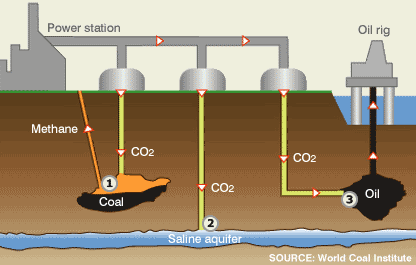Usable electricity doesn’t just appear, but is generated from a pre-existing or primary energy; one of the great decisions of the 21st century will be how we choose to generate electricity. We have established that there are under consideration three main carbon-reduced or carbon neutral “clean” primary energies for electricity: renewable energy, nuclear energy, and coal with carbon sequestration. While electricity itself is “flex-fuel,” meaning any and all of these methods can be used to generate electricity, we will need to arrive at a differentiation of, if not a prioritization of, which methods are going to be the most sustainable and ultimately the main driver of the new electron economy, post-coal and post-oil. To guide policy and investment, we can create a “loading order” for these resources, though a multi-track approach is also probable if not desirable.
Third place: the coal/CCS electron economy
Is coal with carbon capture and storage (CCS) the primary energy source for the Electron Economy? Of the three alternatives, coal generation with CCS is the least promising and has some major strikes against. However, it does have advantages as well.

Pro:
- Taps into a still vast energy store (coal deposits) so can be called upon when needed independent of weather conditions and in response to electric demand.
- Provides jobs and revenue for existing industries and communities (coal mining and coal transport)
Con:
- Uses an unsustainable fuel — coal will run out
- Coal mining is often very destructive to the landscape and to coal miners.
- Mass carbon dioxide release from underground is considered unlikely but potentially lethal for people and wildlife as well as defeating the purpose of CCS.
- CCS may not reduce or eliminate the other pollutants associated with coal combustion including mercury emissions, SOx and NOx.
- There are still no functioning plants/it is an experimental technology.
- CCS plants will be much more expensive than existing coal plants, removing one of the prime selling points of coal, i.e. that it is cheap.
- CCS or “clean coal” has been used as a public relations “cover” to justify the building of new coal generating plants without adding the “optional” CCS facilities.
Coal with CCS may have a role in a transition to a more sustainable energy system but it is by design a stop-gap solution.

